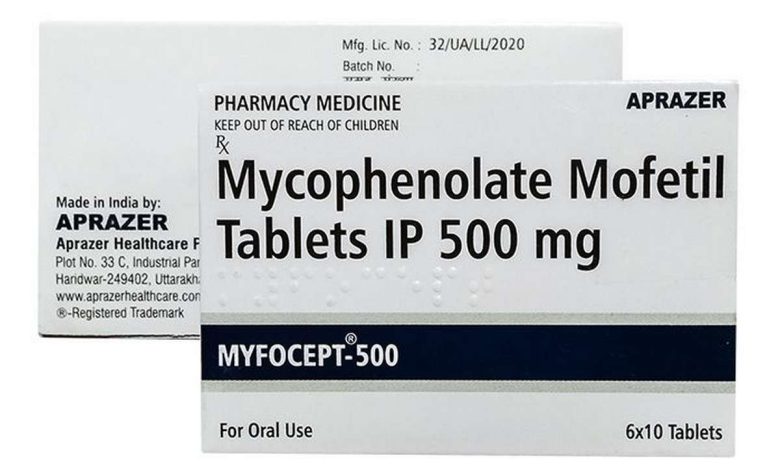Mycophenolate mofetil: instructions for using the medicine, structure, Contraindications

When ATH: L04AA06
Mycophenolate mofetil: pharmachologic effect
Immunosuppressive agent; morpholinoethyl ester of mycophenolic acid, produced by Penicillium stoloniferum. It violates the synthesis of guanosine nucleotides, ingiʙiruja inozinmonofosfatdegidrogenazu. Inhibits the proliferation of T- and B-lymphocytes, as well as the production of antibodies.
Mycophenolate mofetil: pharmacokinetics
Absorption – high, when metabolised “first pass” through the liver, forming an active metabolite – mycophenolic acid.
Bioavailability (aktivnogo metabolite) – 94%; The plasma concentration is reduced by 40% when administered with food. Relationship to plasma proteins – 97%. Mycophenolic acid, is metabolized to form the phenolic glikuroniltransferazoy glikuronida, not having pharmacological activity.
Excretion mainly kidneys, Vide in neaktivnogo metabolite (1% – in unchanged form), through the intestine – 6%.
Patients, recently (less 40 days) Kidney transplant, Cmax aktivnogo metabolites in the plasma of 50% below, than in healthy individuals or in patients, long-transplant.
Mycophenolate mofetil: testimony
Prevention and treatment of rejection after renal transplantation.
Mycophenolate mofetil: dosing regimen
Is used only in combination therapy with cyclosporin and corticosteroids. To prevent graft rejection first dose of MMF taken during the first 3 day after surgery. The ingestion dose is recommended 2 g / day, frequency of administration – 2 times / day.
For the treatment of rejection reactions – 3 g / day.
Mycophenolate mofetil: side effects
From the hematopoietic system: leukopenia, thrombocytopenia, anemia.
From the urinary system: renal tubular necrosis, hematuria, albuminuria, dysuria, hyperuricemia.
Cardio-vascular system: hypertension or hypotension, Arrhythmia, violation of the coronary circulation.
Metabolism: Hyper- or hypokalemia, gipofosfatemiя, Hyper- or hypocalcemia, gipervolemia, Acidosis.
From the digestive system: gingivitis, giperplaziya right, ulcerative stomatitis, nausea, vomiting, stomach ache, constipation or diarrhea, esophagitis, gastritis, gastroenteritis, proctitis, hepatitis.
From the central and peripheral nervous system: dizziness, tremor, sleep disorders, anxiety, depression, drowsiness, paresthesia, conjunctivitis, amblyopia, Cataract.
On the part of the endocrine system: hyperglycemia up to the development of diabetes, hypercholesterolemia, hypoproteinemia, weight gain, impaired function of the parathyroid glands.
On the part of the musculoskeletal system: mialgii, artralgii, cramping of the leg muscles.
The respiratory system: cough, breathlessness, pharyngitis, sinusitis, bronchospasm.
Dermatological reactions: girsutizm, alopecia, itch, acne, skin ulceration, Malignant neoplasms of the skin.
In connection with the immunosuppressive effect may develop infectious lesions of various organs, including infections of the lower urinary tract, candidiasis of the mucous membranes of the gastrointestinal tract, herpes and cytomegalovirus infection, aspergillosis.
Mycophenolate mofetil: Contraindications
Hypersensitivity to mycophenolate mofetil.
Mycophenolate mofetil: Special instructions
Not recommended simultaneous application with azathioprine.
During treatment requires regular monitoring of the blood. As the number of neutrophils to 1300 cells / mm should reduce the dose of MMF or cancel.
Patients, prinimayushtih mycophenolate mofetil, increased risk of lymphoma and other malignancies, in particular, Skin Cancer.
Mycophenolate mofetil: drug interaction
Antacids reduce the absorption; cholestyramine reduces the concentration of active metabolite; tubular secretion blockers increase the concentration of the inactive metabolite.
With the simultaneous use of mycophenolate mofetil and acyclovir increases the concentration of both drugs in plasma.
Cyclosporine A, ganciclovir, cotrimoxazole, oral contraceptives (acute administration) do not affect the pharmacokinetic parameters.
